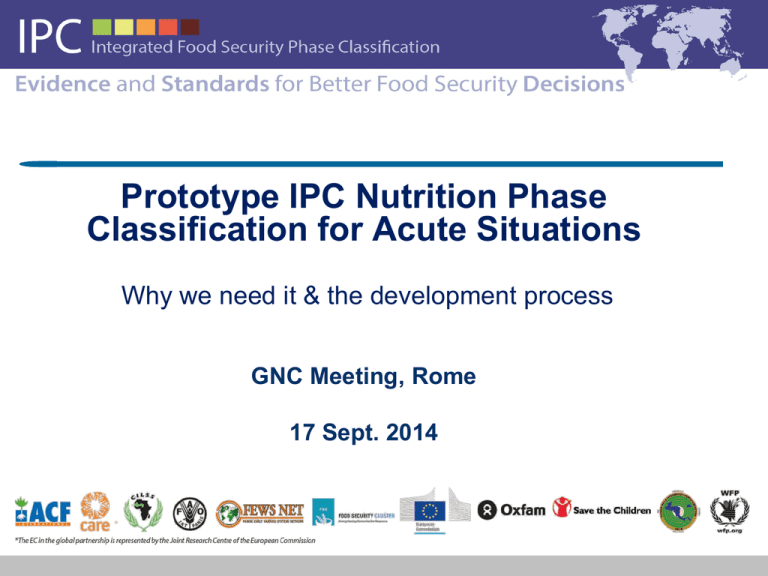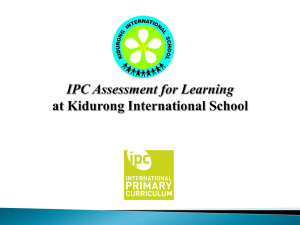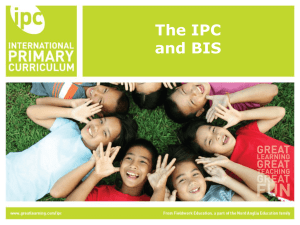IPC-Nutrition-Classification-for-Acute-Situations
advertisement

IPC The Integrated Food Security Phase Classification Prototype IPC Nutrition Phase Classification for Acute Situations Why we need it & the development process GNC Meeting, Rome 17 Sept. 2014 IPC The Integrated Food Security Phase Classification Presentation Outline Prototype IPC Nutrition Phase Classification for Acute Situations • What is IPC? • Why is a nutrition classification needed? • IPC Nutrition Classification - technical development process IPC The Integrated Food Security Phase Classification What is IPC? IPC The Integrated Food Security Phase Classification THE IPC IS….. A set of tools and procedures (protocols) for classifying the nature and severity of food security situations A process for multiple stakeholders to share information and build technical consensus. IPC The Integrated Food Security Phase Classification IPC FOUR CORE FUNCTIONS (1) (2) (3) (4) Building Technical Consensus Classifying Severity and Driving Factors Communicating for Action Quality Assurance EACH HAS A SET OF SUPPORTING TOOLS and PROCEDURES IPC The 4 Functions of IPC Functions The Integrated Food Security Phase Classification 1. Building Consensus 3. Communication 4. Quality for Action Assurance ANALYTICAL FRAMEWORK REFERENCE TABLES ANALYSIS WORKSHEETS Understanding evidence with an integrated Analytical Framework Referencing evidence against international standards Transparently methodically & consensually analyzing evidence SELF ASS. PEER REVIEW COMMUNICATION TEMPLATE Procedures for: Tools TWG MATRIX 2. Classifying Severity & Driving Factors Multi-agency stakeholders to do collaborative analysis Transform analyses into concise information for action 6 Assuring for quality IPC The Integrated Food Security Phase Classification Why is nutrition classification needed? IPC The Integrated Food Security Phase Classification Why an IPC Nutrition phase classification for Acute Situations - Background IPC Acute Food Security Phase Classification Proven Applicability and Relevance - Globally Asia & Near East Africa Central America & Caribbean North Africa & Near East Central Asia IPC The Integrated Food Security Phase Classification Why do we need an IPC Nutrition Classification for Acute Situations? Two Situations We Observe: 1. Low severity of acute Food Insecurity and High levels of acute Malnutrition – Why? Casual factors are not food security related – A public health issue, related to social and care environment and access to health services and health care environment IPC The Integrated Food Security Phase Classification Example: FSNAU Nutrition & Food Security Situation in Somalia IPC The Integrated Food Security Phase Classification Why do we need Both Classifications? 2. High severity of acute Food Insecurity and Low levels of acute Malnutrition Why? 2 possible reasons Lag effect o o Body Tissue and muscle loss related to underlying causes of food insecurity – depends on severity of food inadequacy Can take time before it manifests, some cases ‘’late indicator’’ IPC The Integrated Food Security Phase Classification Why do we need Both Classifications? Mitigating Factors o o Coping strategies in household, e.g. prioritize the children, until deplete their coping strategies. Accessible and Effective Public Health Services, that mitigate effects of acute malnutrition, though food insecurity still problem IF there are social protection programme, strong coping capacity: nutrition indicators - lag effect or no manifestation IPC The Integrated Food Security Phase Classification How is Nutrition Currently Integrated in IPC? IPC The Integrated Food Security Phase Classification Identified Gap & Country Requests To date - IPC focused on the analysis and classification of food security situations and outcomes Nutrition is integrated within the IPC FS analysis, – – – Not a full analysis of the Nutrition situation and outcomes Nutrition only in relation to Food Security Malnutrition caused by non-food security are not included, i.e. inadequate caring practices and disease IPC UNICEF’s Conceptual Framework on The Integrated Food Security Phase Classification the Causes of Malnutrition Core outcomes Immediate Causes Underlying Causes Basic Causes Malnutrition & Death Inadequate Food Intake Household Food Security Disease Social and Care Environment National Policies Formal and Informal Structure Context and Potential Resources Access to Health Care & the Health Environment IPC The Integrated Food Security Phase Classification How is IPC FS linked with the Nutrition Classification? IPC Acute Food Security informs the Analysis of Household Food Security Malnutrition & Death Inadequate Food Intake Household Food Security IPC The Integrated Food Security Phase Classification What is needed in IPC? IPC The Integrated Food Security Phase Classification What is needed to complement the IPC Acute Food Insecurity Phase Classification? The Prototype IPC Nutrition Classification for Acute Situations - elaborates and measures the non-food factors and drivers of malnutrition Malnutrition & Death Disease Social and Care Environment Access to Health Care & the Health Environment IPC UNICEF’s Conceptual Framework on The Integrated Food Security Phase Classification the Causes of Malnutrition IPC Nutrition Malnutrition Classification for & Death Acute Situations Inadequate Food Intake Household Food Security IPC Acute Food Security Classification Disease Social and Care Environment Access to Health Care & the Health Environment IPC The Integrated Food Security Phase Classification Prototype IPC Nutrition Classification for Acute Situations • IPC Acute Food Security Classification – provides the full analysis of acute food security, and food security factor analysis for the IPC Nutrition Classification for Acute Situations • IPC Nutrition Phase Classification for Acute Situations – provides the full analysis of acute malnutrition outcomes, nonfood factors and food factor analysis. Where food factors analysis is provided by the IPC Acute Food Security (Inter-locking) Complementary Inter-linking Phase Classifications – IPC Acute Food Security Phase Classification & IPC Nutrition Phase Classification for Acute Situations are to be complementary & inter-locking – Together provide the full analysis of acute food and nutrition security situation IPC The Integrated Food Security Phase Classification Development Process: Nutrition Phase Classification for Acute Situations IPC The Integrated Food Security Phase Classification IPC Global Steering Committee Endorsement In 2013 - the IPC Global Steering Committee endorsed resolution to develop IPC Nutrition Phase Classification for Acute Situations The SC endorsed the use of Food Security and Nutrition Analysis Unit (FSNAU) Acute Nutrition Classification Tool as a base – Developed & Implemented along side the IPC Food Security Phase Classification, since 2007 in Somalia Formation of IPC Nutrition Working Group of the IPC Global Technical Advisory Group (TAG) – to lead technical development & piloting – Technical Experts from both the global food security and nutrition community IPC The Integrated Food Security Phase Classification Prototype IPC Nutrition Classification for Acute Situations Based on the Acute Nutrition Classification Tool , an IPC Nutrition Classification for Acute Situations prototype has been developed. Prototype is the refined version of the FSNAU Nutrition Classification Tool – Analytical Framework – – IPC Analytical Framework UNICEF & Lancet Conceptual Framework Reference Tables for Nutrition Classification Mapping Protocol IPC The Integrated Food Security Phase Classification Prototype IPC Nutrition Classification for Acute Situations Prototype IPC Nutrition Phase Classification for Acute Situations – Focused on analysis of Acute Malnutrition – Classification of the Severity of Acute Malnutrition & identification of contributory factors Pilot test and revise by the global IPC NWG for universal applicability IPC The Integrated Food Security Phase Classification Prototype IPC Nutrition Classification for Acute Situations Share same IPC Protocols and Four Core Functions (1) (2) (3) (4) Building Technical Consensus Classifying Severity and Contributory Factors Communicating for Action Quality Assurance IPC The Integrated Food Security Phase Classification IPC Prototype Nutrition Classification for Acute Situations Reference Table – Outcome Indicators Indicator GAM among children 6-59 months (%) Acceptable <5 Alert 5-9.9 Serious 10-14.9 Critical 15-29.9 Very critical ≥30 MUAC <125 mm among children 6-59 months (%) <2.0% 2.1-5.5% with increase from seasonal trends 5.6-8.0% 8.1-19.9 %, or where there is significant increase from seasonal trends ≥20.0%, Or where there is significant increase from seasonal trends Very low (<5%) and stable levels Low levels (5 to <10%)and one round indicating increase, seasonally adjusted Low (5 to < 10%) & increasing or moderate (10 to <15%) levels based on two rounds (seasonally adjusted) High levels (> 15%) of malnourished children and stable (seasonally adjusted) High levels (> 15%) and increasing with increasing trend (seasonally adjusted) V. low (<5%) proportion in the preceding 3mths relative to >2yr seasonal trends Low proportion (5 to <10%) and stable trend in the preceding 3mths relative to >2yr seasonal trends Moderate (10 to <15%) and stable or low (5 to <10%) but increasing proportion in the preceding 3mths relative to >2yr seasonal trends High (> 15%) and stable proportion in the preceding 3mths relative to >2yr seasonal trends High (> 15%) and increasing proportion in the preceding 3mths relative to >2yr seasonal trends TBD <1.0 TBD <1.0 TBD 1.0-2.0 Sentinel Site Data HMIS Data Programme Data Screening (purposive) (%) TBD 2.1-3.0 TBD 3.1-5.5 IPC The Integrated Food Security Phase Classification IPC Prototype Nutrition Classification for Acute Situations Reference Table – Contributory Factors (1/3) Food security Indicator Food Consumption Score (FCS) Acceptable Acceptable consumption Alert Acceptable consumption (but deteriorating) Serious Borderline consumption Critical Very critical [below] poor consumption Poor consumption Coping Strategies Index (CSI) Reference, stable Reference, but unstable Reference and increasing Significantly > reference Far > reference Household Hunger Score (HHS) None (0) Slight (1) Moderate (2-3) Severe (4-6) Severe (6) Household Economy Approach (HEA) No livelihood protection deficit Small or moderate livelihood protection deficit Substantial livelihood protection deficit or small survival deficit of <20% Survival deficit >20% but <50% with reversible coping considered Survival deficit >50% with reversible coping considered Consolidated Approach for Scoring Indicators of Food Security (CARI) See attached table IPC The Integrated Food Security Phase Classification IPC Prototype Nutrition Classification for Acute Situations Reference Table – Contributory Factors (2/3) Social and care environment Indicator Acceptable Breastfeeding (BF) Practices i) Exclusive BF for 6mths ii) Continued BF at 1 year iii) Continued BF at 2year reference Complementary feeding in addition to breastfeeding i) Introduction of complementary food at 6 months of age: %introduced ii) Meeting minimum recommended feeding frequency Maternal Wellbeing Index Caregiver workload TBD Alert Serious >90% >90% >90% 50-89% 50-89% 50-89% 12-49% 12-49% 12-49% ≥95% ≥95% 80-94% 80-94% 60-79% 80-94% Critical Very critical 0-11% 0-11% 0-11% 0-59% 0-59% 0-59% 0-59% IPC The Integrated Food Security Phase Classification IPC Prototype Nutrition Classification for Acute Situations Reference Table – Contributory Factors (3/3) Access to Health Care & Health Environment Diseases/nutritional deficiencies Indicator Diarrhoea Cholera ARI Measles Malaria Acceptable Normal levels, & seasonal trends, Review data in relevant context Alert -AWD 1 case -Suspected cholera 1 case -Suspected measles 1 case -Suspected malaria–doubling of cases in 2 weeks in hyper endemic areas–using RDT (WHO); OR increasing weekly trend (UNICEF) Micronutrient deficiency outbreaks Anaemia Indicator Availability of iodised salt at the HH level Vaccination coverage (Measles and vitamin A) ANC Coverage Low Birth Weight Coverage of outreach programmes Access to safe WASH Indicator Population have access i) to a sufficient quantity of water for drinking, cooking, personal & domestic hygiene–min 15lts Serious Critical Very critical Outbreak not contained and/or in non-endemic area – limited access to treatment: CFR for AWD >2% rural CFR for AWD >1% urban AWD – duration exceed >6 wks Severe ≥ 40 Moderate 20 – 39.9 Mild 5 – 19.9 Severe ≤ 4.9 Acceptable TBD >95% >95% TBD TBD TBD Alert TBD TBD TBD TBD Critical TBD 80-94.9% 80-94.9% TBD TBD TBD Very critical TBD TBD TBD TBD Acceptable 100% Alert TBC Serious TBC Critical TBC Very critical TBC 100% TBC TBC TBC TBC IPC The Integrated Food Security Phase Classification Communication for action Map IPC Pilot Nutrition Classification, Kenya Map IPC Pilot Nutrition Classification, South Sudan IPC The Integrated Food Security Phase Classification Timeline & Work Plan Two Year - Piloting and development period (2014-2015) – – 2014-15 development of IPC Prototype based on FSNAU tool, Pilot and Refine/Revise 2016 Expected Roll-out of V.1.0 IPC Nutrition Classification Process – Technical Consultations & Deliberations combined with Country Pilots & Learning for Refinement of tool 2014 Timeline & Work Plan – – – – – – Launch of IPC Global Nutrition Working Group, March 25, 2014 First IPC NWG Meeting: June 23-25 Development of Tools and First Round of Pilots: July – Aug 2014 (Kenya and South Sudan) Second IPC NWG Meeting: Sept 2014 Second Round of Pilots: Oct – Nov 2014 (Bangladesh, Haiti, and Niger) Third IPC NWG Meeting and planning for 2015, Dec 2014 IPC The Integrated Food Security Phase Classification Thank you www.ipcinfo.org







